Ett platsspecifikt plugin gör att du enkelt kan lägga till fragment kodu till din WordPress-webbplats utan att förlita dig på ditt tema. Det gör att du kan använda anpassad kod för att förbättra din webbplats och inte oroa dig för att behöva göra om allt när ditt tema uppdateras.
På WPBeginner har vi tidigare skapat massor av platsspecifika plugins för att lägga till krótki koder, nya inläggstyper och andra funktioner på vår webbplats. Dessutom har vi hjälpt våra kunder att komma igång med platsspecifika plugins.
I den här artikeln förklarar vi hur du skapar ett site-specifikt WordPress plugin och varför det är viktigt.
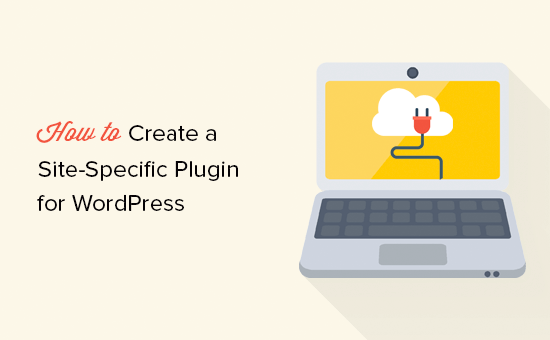
Vad är ett site-specifikt tillägg till WordPress?
Ett site-specifikt WordPress plugin är ett fristående plugin som du kan använda för att add to all customomize snippets som inte är theme-beroende.
När du arbetar med din webbplats kommer du ofta att hitta poradnikar för WordPress som ber dig att lägga till kod i ditt temas functions.php-fil eller ett webbplatsspecifikt plugin.
WordPress levereras inte med ett plugin som är specifikt för webbplatsen. You will need to create your own and then install and activate it.
Varför skapa ett site-specifikt WordPress tillägg?
Som vi nämnde tidigare kommer du ofta att stöta på poradnik som visar lite kod som du kan lägga till i ditt temas functions.php-fil eller ett webbplatsspecifikt plugin.
Dessa anpassade koder kan användas för att lägga till nya inläggstyper, taxonomier, krótki koder och massor av hack för att förbättra din webbplats.
Om du addar den customizen till ditt temas functions-fil kommer den att försvinna om du updatear eller byter tema.
Du kan skapa ett barn tema och använda barntemats functions-fil för att save your code. Din kod kommer dock fortfarande att försvinna om du byter theme.
Ett site-specifikt WordPress plugin allow you to easily add custom code snippets to your WordPress website and make sure they are theme-independent. Det är ett fristående WordPress plugin, vilket innebär att det inte är beroende av ditt theme, och you are free to update or switch your theme.
Med detta sagt, låt oss ta en titt på hur man enkelt kan add to custom code med hjälp av ett site-specifikt plugin. Vi kommer att visa dig två sätt att göra det, och du kan välja den metod som fungerar bäst för dig (ledtråd: Metod #2 är lättare för Beginnare).
Metod 1: Skapa ett tillägg till WordPress som är specifikt för webbplatsen manuellt
Vi vet att det här kan låta lite nördigt för Beginnare, men vi ska försöka göra det så enkelt som möjligt för You.
Först måste du skapa en new folder på skrivbordet och döpa den efter din website. Till exempel: mywebsite-plugin.
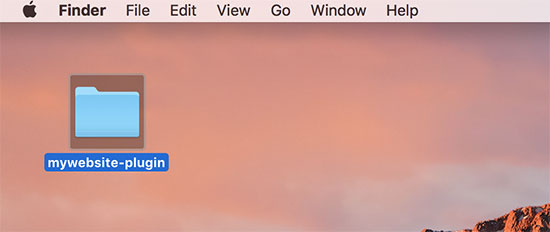
Öppna nu en plain text editor på din dator som gillar Notepad eller TextEdit.
You need to create a new file and save it as mywebsite-plugin.php in the plugin folder on your desktop.
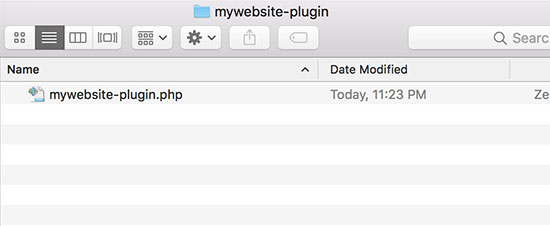
Din plugin-fil behöver en specifik header-kod så att WordPress kan känna igen den som ett plugin. Gå vidare och add följande kod till din mywebsite-plugin.php-fil:
1 2 3 4 5 6 7 8 9 | <?php/*Plugin Name: Site Plugin for example.comDescription: Site specific code changes for example.com*//* Start Adding Functions Below this Line *//* Stop Adding Functions Below this Line */?> |
Du kan ersätta example.com med ditt eget domain name. När du har gjort det är ditt site-specifika plugin klart.
Det finns två sätt att uploada ditt site-specifika plugin till din website. Du kan antingen uploada det via din WordPress adminpanel eller använda FTP.
1. Installera site-specifikt tillägg från WordPress Admin Area (rekommenderas)
Denna metod är enklare och rekommenderas för alla användare.
Först måste du skapa en ZIP-fil med din site-specifika plugin folder.
Windows-användare kan helt enkelt högerklicka på plugin-mappen och select Skicka till ” Komprimerad (zip) folder.
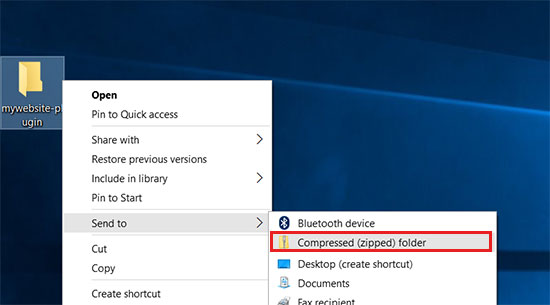
Mac-användare måste högerklicka.
Välj sedan “Komprimera mywebsite-plugin”.
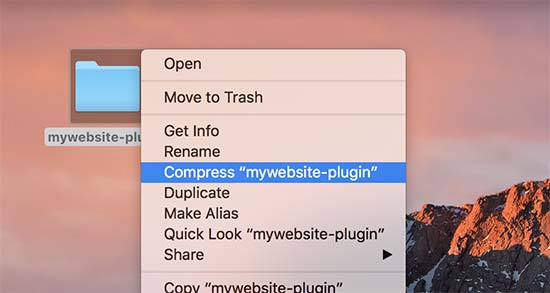
När du har pluginets ZIP-fil, gå till Plugins ” Add New page i din WordPress admin area.
Klicka sedan på knappen “Upload Plugin” högst upp.
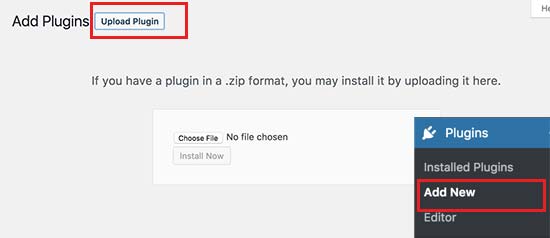
Klicka sedan på knappen “Choose File” för att selecta zip-filen som du skapade tidigare och klicka sedan på knappen “Install Now”.
WordPress kommer nu att uploada och installera pluginet åt dig. När det har laddats upp måste du klicka på knappen “Activate Plugin” för att börja använda ditt site-specifika plugin.
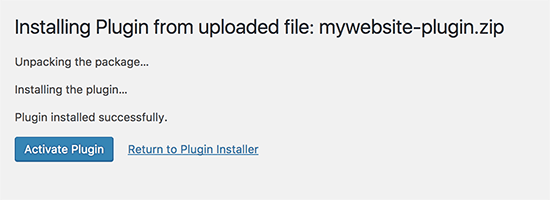
2. Uppladda ditt site-specifika tillägg till WordPress via FTP
För den här metoden behöver du inte skapa en ZIP-fil. Du kommer att uppladare pluginet via FTP.
Först måste du ansluta till din website med hjälp av en FTP-klient.
När du har anslutit, gå till /wp-content/plugins/ folder under remote site column. Därefter måste du välja din site-specifika plugin folder och uploada den till din website.
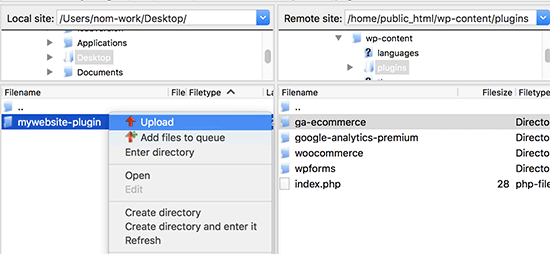
Din FTP-klient kommer nu att överföra din site-specifika plugin folder till din WordPress website. Detta installerar pluginet på din website.
Du måste dock fortfarande aktivera pluginet för att börja använda det. Du kan göra detta genom att gå till sidan “Plugins” i ditt admin area i WordPress och sedan klicka på länken “Activate” under ditt site-specifika plugin.
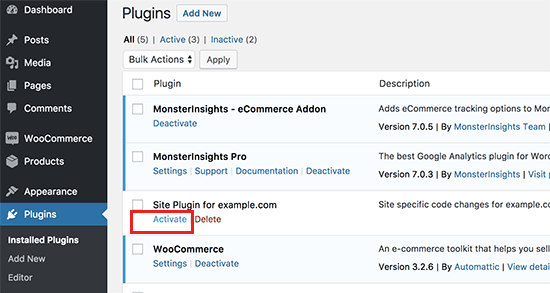
Nu är allt klart. Ditt site-specifika plugin är nu redo att användas.
Lägga till anpassade code snippets till din site-specifik plugin
Det finns två sätt att edit your plugin och add custom code snippets till det.
Den första metoden är att göra det via WordPress admin area. Du kan gå till Plugins ” Editor page.
Du kommer att se ett varningsmeddelande och du måste klicka på knappen “Jag förstår” för att fortsätta. Om du vill ha ett säkrare sätt att editera filerna kan du hoppa till den andra metoden under.
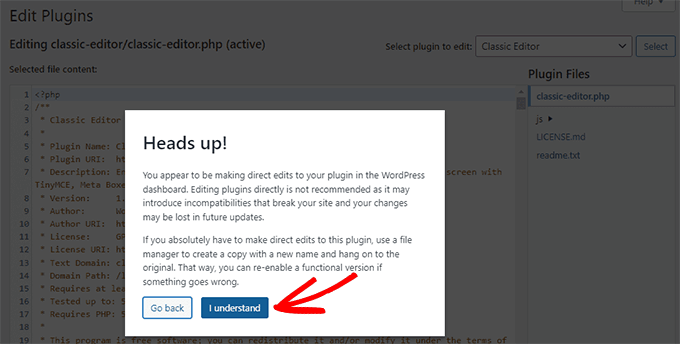
Därefter måste du välja din site-specifika plugin från rullgardinsmenyn märkt “Select plugin to edit.
The editor kommer att hämta din plugin-fil och du kommer att kunna add to code snippets till den.
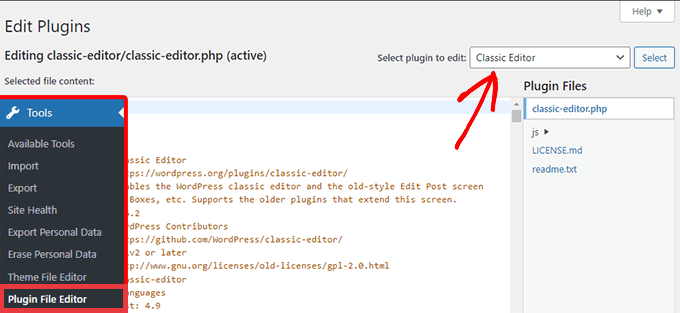
När du är klar klickar du på knappen “Update File” för att save your changes.
Om det saknas något i din kod eller om det har potential att förstöra din website, kommer plugin editor automatiskt att ångra dina ändringar.
Men om editorn Misslyckas, och du ser den vita vyn av död, kan du använda FTP för att redigera din plugin-fil och ångra dessa ändringar.
Den andra metoden är att direkt editera plugin-filen med hjälp av FTP. Gå helt enkelt till plugin foldern med din FTP-klient. Högerklicka på filen med pluginet och välj sedan “View/Edit”.
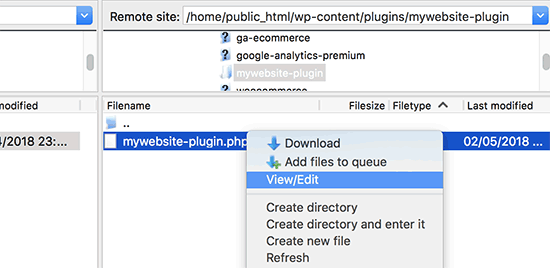
You can also download the plugin file to your computer, edit it, and then upload it back.
Metod 2: Lägga till Custom Code med hjälp av WPCode (rekommenderas)
Den här metoden är mycket enklare och ger dig ett bättre sätt att hantera dina enskilda code snippets i WordPress med hjälp av WPCode.
Det första du behöver göra är att installera och aktivera det gratis pluginet WPCode på din website. För mer detaljer, se vår Step-by-Step guide om hur du installerar ett WordPress plugin.
Relaterat inlägg: För mer information, kolla in vår fullständiga recension av WPCode.
Vid aktivering kommer pluginet att lägga till ett nytt menu item märkt “Code Snippets” till din WordPress admin menu. Om du klickar på det kommer du till en page där du kan hantera alla dina custom codes.
Om du vill lägga till ditt första code snippet klickar du på knappen “Add New”.
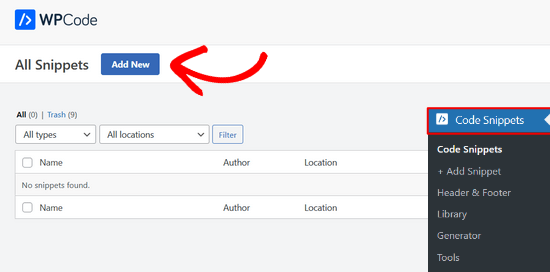
Då kommer du till sidan “Add Snippet”. Här kan du välja ett code snippet från det färdiga biblioteket eller add to din custom code.
För att add a custom code, navigera till alternativet “Add Your Custom Code (New Snippet)” och click the “Use snippet” button.
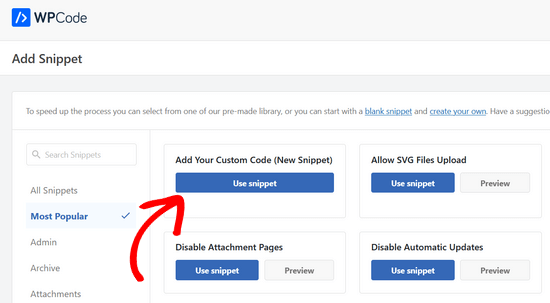
Nu kan du enter en titel för din custom code snippet. Det kan vara vad som helst som hjälper dig att ID:a koden.
Efter det kan du gå vidare och klistra in ditt fragment kodu i kodrutan. Du måste också välja typen “PHP Fragment Kodu” från rullgardinsmenyn “Kodtyp” till höger.
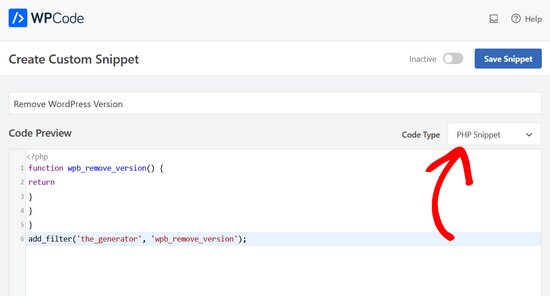
You can also add notes for the code in the “Basic info” section.
Du bör använda detta area för att skriva ner vad koden gör, var du hittade den och varför du lägger till den på din website. Detta kommer att hjälpa “framtida you” att komma ihåg varför “tidigare you” adderade den här koden.
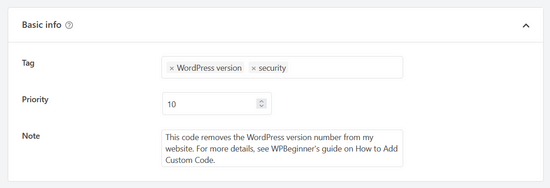
Du har också alternativet att tilldela taggar till dina code snippets, vilket kan hjälpa till att organisera code snippets efter ämne och funktionalitet.
Pluginet tillåter dig också att selecta hur du vill köra code snippet. I section “Insertion” kan du selecta metoden “Auto Insert” för att automatiskt infoga och exekvera koden på din site.
Du kan välja mellan alternativen admin area, front-end eller överallt. Om du är osäker behåller du standardalternativet “Run Everywhere”.

Eller så kan du välja “Shortcode”-metoden. Med den här metoden infogas snippet inte automatiskt. När du har saved snippet får du en shortcode som du manuellt kan insert var som helst på din site.
You can also use the “Smart Conditional Logic” section to either show or hide auto-inted snippets based on a set of rules.
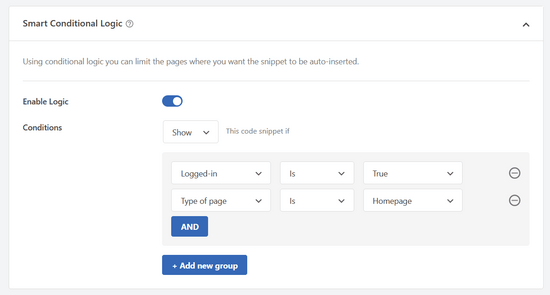
Du kan till exempel ladda code snippets endast för inloggade användare, ladda PHP code snippets endast på specifika pages URL:er, visa code snippets baserat på typen av page, med mera.
Slutligen kan du toggle omkopplaren från “Inaktiverad” till “Aktiv” och sedan klicka på knappen “Save Snippet”.

Om du vill spara code snippet utan att aktivera det kan du bara klicka på knappen “Save Snippet”.
När du har saved och aktiverat ett code snippet kommer det automatiskt att börja gälla på din website om det är den insert-metod du har valt.
För mer detaljer, se vår guide om hur du enkelt lägger till custom code snippets i WordPress.
Vi hoppas att den här artikeln hjälpte dig att lära dig varför och hur du skapar ett site-specifikt WordPress plugin. Du kanske också vill se vår lista med användbara tips om funktionsfiler och de mest efterfrågade WordPress-hackarna för att bäst använda ditt site-specifika plugin.
If you liked this article, then please subscribe to our YouTube Channel for WordPress video tutorials. You can also find us on Twitter and Facebook.





Stephanie
I’m getting the same error as Sonya above. Does anyone have a fix?
Parse error: syntax error, unexpected T_LNUMBER in /home/statisu0/public_html/wp-content/plugins/statisticshowto-plugin/statisticshowto.com-plugin.php on line 10
WPBeginner Support
your plugin file name contains .com in it. It should be statisticshowto.php instead.
Admin
Susan
Hi again. I’ve been reading through all of the comments above and, while some show your answer and resolution to the problem, many don’t. So it’s hard for me to learn from how others resolved their problems! Anyway, here’s what I’m wondering: if by following the instructions in this post to create a folder within my “plugins” folder, how will I be able to see my new site-specific plugin file?
For example, I followed the instructions to create a folder called susansinthegarden-plugin. Then I put my plugin code in a file called susansinthegarden-plugin.php. I can’t see the plugin when I go to plugins on my dashboard.
Is this because the new plugin text file exists in a sub-folder under “plugins”? I can’t figure out what I’m missing but really need to resolve this. Is there anyone out there who can help me? Thanks so much!
WPBeginner Support
No. Please make sure that your plugin’s header area is properly formatted.
Admin
emy
Hi,
What is a plugin header and how do I format it?
WPBeginner Support
Hey Emy,
The plugin header is the part that tells WordPress that this file should be treated as a plugin. It also tells WordPress the name of the plugin, version, and other information.
In the code shown above, the header part begins right after the first line and ends at line 5. It contains plugin’s title and description.
Susan
OK, I resolved my program. Not being a code-writer, I didn’t realize that there was a separate header to wrap around the code I was borrowing. Duh. Thanks for your help.
Susan
I followed your instructions to create a folder under wp-content/plugins etc. and put the file containing the code into that folder but I can’t see my new plugin when I go to my dashboard and look under plugins. Did I miss a step? Thanks in advance for your help!
Edgar Ramirez
Hello
I created the directory and the php file but i cannot see the plugin at all
/wp-content/plugins/yoursitename-plugin/
Open a blank file and save it as “yoursitename-plugin.php”
dont see it on the dashboard plugin list and neither in the Plugin>editor
Can you please help me
Sonia Lacasse
Never mind! Looks like I found the problem. Thanks for your awesome work!
Sonia Lacasse
When I try to activate the plugin, I get the following error message:
Plugin could not be activated because it triggered a fatal error.
Parse error: syntax error, unexpected ’06’ (T_LNUMBER) in /var/www/domain/wp-content/plugins/ETK-PLUGIN/ETK-PLUGIN.php on line 10
Can you please help?
Thanks!
Catherine Argyros
hi there, when i put this in the directory
I received this error message
The plugin generated 2 characters of unexpected output during activation. If you notice “headers already sent” messages, problems with syndication feeds or other issues, try deactivating or removing this plugin.
but my plug in is activated….. please help me understand what is going on?
thank you
WPBeginner Support
Most probable cause for this error could be an empty space after the last ?> closing tag.
Admin
error message
wonderful, thats exactly what the problem was. Thank you for helping me create my first plugin!
WPBeginner Support
Glad to help
xin a day
“All you have to do is create a new folder in the plugins directory. Example: /wp-content/plugins/yoursitename-plugin/
Open a blank file and save it as “yoursitename-plugin.php”
Put the following code in the file:”
i hv few question on these .
1. i can’t create a folder onthe plugin directory.
2. where to open a blank file ?
3. the plugin diretory cant install that file.
thank you
Sacha
Awesome idea! I’ve always found functions.php a pain, so this method works great!
Alan Shapiro
This is a really useful post–thank you! Perhaps someone else asked this and I just missed it in all the comments, but: will a site-specific plugin override a function that is in the theme’s functions.php? For instance, if there is a “remove_action” in the functions.php, will the same “add_action” in the plugin take precedence?
WPBeginner Support
Both functions.php file and site-specific plugin are treated as plugins. Functions.php file loads after plugins but they do not have precedence over eachother. This is why using the same function in both files can cause unexpected results. The best way to override pluggable code is by using hooks and filters.
Admin
Robert Masters
I’m building a plugin at the moment for a multisite network and I need certain functionality available only in specific sites, so this is a perfect article for me right now.
I have one question though…..how do I name the site plugin folder for a site that is created as a subdomain? Example: subdomain.mainsite.com would it be subdomain-mainsite-plugin or just subdomain-plugin?
Hope this makes sense, question based on your tutorial.
hans
very good. when you create a second instance don’t forget do give the “register and load” function an own name, like i did
Eric Ellis
That’s great. I always figured it was pretty simple. Thank you for the information.
Jide
Nice one there. Kindly update the post to inform readers that after activating the plugin, they will have to click on the “edit” link on the plugins page, to add their codes.
Most newbies might not know this…
WPBeginner Support
Actually we do not recommend editing plugins and themes from WordPress admin area. Instead, we would recommend editing your plugins in a text editor via FTP client. This way in case of an error you would be able to quickly fix it without losing access to admin area for too long.
Admin
Mark Holland
Thank you thank you thank you!! This has solved an issue that’s been puzzling me for weeks – and now solved in less than 1 minute.
Can’t express how grateful I am for you sharing your knowledge – thanks again!
Luca
Thank you for the advice! But now I’m confused: what’s the difference between this method and the plugin “Code Snippet”? Is the result the same? Or do they accomplish the same thing in a different way?
Malcolm
Three years later this post is still giving – It’s changed the way I think about customising wordpress – Thank you!
I tried this today and created a a site-specific-plugin with code to hide the wordpress menu bar for non-admins, and to add my latest post to a ‘Current issue’ menu item. Both worked perfectly.
But the third snippet I added to the plugin failed to work. When I copied the code to the child theme’s functions.php it worked as expected.
Can you explain why this would happen?
I’m trying to modify the effect of the plugin “Restricted Site Access” by allowing access to more than a single page. The code I tried in my site specific plugin and the functions.php was:
//
add_filter( ‘restricted_site_access_is_restricted’, ‘my_restricted_check’ );
function my_restricted_check( $is_restricted ) {
global $wp;
if (
$wp->query_vars[‘pagename’] == ‘contact’ ||
$wp->query_vars[‘pagename’] == ‘subscribe’ ||
$wp->query_vars[‘name’] == ‘aplr-2013-volume-21-number-2’
)
$is_restricted = false;
return $is_restricted;
}
Any advice or comment would be welcome. I’m confused!
harklord
after trying this. My site is opening blank… Please help.. Av tried deleting the files i created but still blank
WPBeginner Staff
Make sure that your stored the plugin’s php file in /wp-content/plugins/ folder and not in your theme directory.
Mohammed Amine
Fixed, actually it is necessary to add that php comment in the php file, or else it wont appear on the admin panel.
That php comment is used to show the discription of the plugin in the admin panel.
Paolo Bergomi
Hello,
This is Paolo, i am building my website and theme with WP last edition 4.1.1.
i Am trying to learn custom type fields and I found your website very useful. i hav ea issue, though: even if following this post i created the folder my theme plugin and with the related file .php you mentioned here, for the site specific plugin, copy all in localhost using WAMP server. i opened then my dashboard, went to plugins but my new plugin dont appear. what is going on? did i miss anything? thanks
paolo
WPBeginner Staff
You can try and fit your modifications in site-specific plugin by using filters. However, since you had to edit specific files we doubt that all your edits can be implemented in a site-specific plugin using filters. In that case you should make those changes into a child theme. All your custom CSS should also go into your child theme’s stylesheet. You can also use your site-specific plugin to enqueue a custom stylesheet.
Bas van der Linden
Hmm, looks like my last post went missing while registering for this annoying disqus plugin.
Anyways:
At first I’d like to thank you for sharing this information.
Secondly I do have several questions regarding this post.
1) Is it possible to also make site specific plugins for other .php’s where I’ve added some codes?
Such as front-page.php post-page.php and post-archives.php
2) Is it possible to do something like this for .css codes?
I run genesis as framework(Parent theme) and a child-theme that I’ve downloaded.
Now since there are no grand-child theme’s in wordpress I’ve made my alterations in the child-theme’s folder
This includes a lot of different .css edits, Is there a way to make site specific .css files/plugins like this, so I can maintain the origional child-theme (and perform an update if any updates are released)?
3) When I create a site-specific plugin to change the footer and activate it, I will see both the origional footer and my own footer on the site.
Is there a way to go around this?
My plugin looks like this:
Once again thank you for sharing this information on site-specific plugins, and I hope to hear soon from you guys.
Chelsey
Thank you for your patience… I’m still trying to figure out how to ‘create a new folder to plugins directory’
Rodney Lacambra
Hi Chelsey. Consider this guide:
Go to “File Manager”. It will take you to “/public_html” directory. Click on “wp-content >> plugins” . This is where you will “create” a folder called “yoursitename-plugin”. After that, create a file using some text editor(notepad++), paste the code given above and save the file as “yoursitename-plugin.php”. Upload it to “yoursitename-plugin” folder and activate it in your wordpress admin area. Easy as that!
Hope it helps you a lot.
Regards,
NomadTech
Benjamin Mukasa
This is a great post. I followed the instructions but the plugin is not appearing in my plugin list.
Paolo Bergomi
me same..where did we make wrong? thanks in advance for any tips to solve this
WPBeginner Staff
yes you can use it for multiple functions.
WPBeginner Staff
Your code seems to be correct. Here is what you can do:
Make sure you have saved the plugin file in the /wp-content/plugins/ directory.
Make sure that your plugin file name is correct. We recommend using yoursitename.php format. For example if your domain name is black-circles then your plugin file name should be black-circles.php
SteveMTNO
I originally had the plugin file (bc-plugin.php) in its own directory called blackcircles/wp-content/plugins/bc-plugins. That didn’t work.
Then I tried moving the bc-plugin.php file from that folder to the blackcircles/wp-content/plugins folder. Still doesn’t show up in my admin panel.
Do I have to “enable” it first before it shows up or something?
Confused….
WPBeginner Staff
If the file is correctly placed in your plugins folder then you will see it in your WordPress admin area under Plugins. If you see your plugin there, then you will have to click on the activate link below the file to activate the plugin.
Did you try renaming the file to something else?
SteveMTNO
Tried renaming it 3 times – none of them show up….
I must be doing something wrong (or not doing something that I should be doing)…
SteveMTNO
So can I use this one site-specific plugin for multiple functions, or is it best to do something similar to this for each one?
Michael Cuomo
I’m having a similar issue with mine. I’ve created a site specific plugin to create a custom content type, but the custom content type is not showing up in my admin panel underneath pages like it should.
SteveMTNO
I posted this yesterday, but it seems to have vanished…
Anyway, I followed the instructions above, but can’t see the site-specific plugin in my admin panel.
Here’s a link to my code:
http://pastebin.com/fbeGr8gh
SteveMTNO
I followed all of the instructions above, but my plugin doesn’t appear in my admin panel.
Here’s my pastebin link:
http://pastebin.com/fbeGr8gh
Thanks!
SteveMTNO
WPBeginner Staff
There were spaces in your PHP opening and close tags
is the closing tag there is no space between them. See the corrected version here and compare it with your code. Hope this helps
http://pastebin.com/JJ7WfpUR
UgochukwuEmmanuelAgbams
i got this message while trying to install it.
The package could not be installed. No valid plugins were found.
WPBeginner Staff
This usually happens when your plugin’s header is not valid. Please paste your code in pastebin.org and paste the link in a comment.
UgochukwuEmmanuelAgbams
thank you for your response. here is the link of the code on pastebin http://pastebin.com/vksUVmCa
Rajesh Ghadge
Very useful aticle it can help any novice in the designing field thanks a million
Joe Librizzi
This is a fantastic post, thanks! Quick question – could this same method be used to modify an existing plugin, sort of like you can use a child theme to modify existing CSS? I know you can modify a plugin directly, but I’m trying to avoid losing the modifications when the plugin is updated.
WPBeginner Support
Joe, yes this can be used to modify plugins. Another way to modify plugins safely is by changing their header information. You can use the header shown in the above code as an starting point.
Admin
Correen
Successful! Thanks for showing me how to get this accomplished.
Chris
I am new at this and learning as I go but I am confused as in the instructions both the singular and plural version of plugin was used. Am I to create one plugin file to put all snippets into or seperate plugins for each code/snippet/task?
For example – I found this article by gooling for how to create more than one custom post type. Would I put each custom post type into a seperate plugin?
Or could the code for custom post type go into the same plugin file as theme support for post thumbnails as I have it currently in my functions.php?
WPBeginner Support
The code for all your custom post types can go in one plugin.
Admin
Shemul
what about custom.css? can we made something like this. it is good to have child theme then.
WPBeginner Support
A child theme is always recommended but there is a fine line as to how much functionality themes should have and what functionality should fall under plugin domain.
Admin
Sussie T
Great article. I did this, and it was very easy. But now I am taking this further and made another file to my plugin for the site specific widgets. My first widget.
Have fully created 2 widgets, but only the last one is showing in admin. I guess is something with hooks or register_widget, but i cant crack this one.
Seams like an easy error to solve, if you got the experience. But for a beginner Google is not helping at all.
Resume of my widget file:
widget script
widget script
a function witch registers my 2 widgets
Outside this function is add_action(widgets_init, name of above function)
Please help
paul
so when i read
Paste this code in your theme’s functions.php file or your site-specific plugin
i just create this site-specific plugin and add code to this rather than my functions.php
Duy Dang
Thank you so much, it’s very useful!
Junior Godoi
And what about mu-plugins folder?
Max
Your site is god sent! I’ve literally been going through each of your tutorials, making a list of all the one’s I’m going to be implementing on my new site I’m developing. Some things you have covered, I would of never even have thought about, but now I am definitely dong them. Thanks for all the information you provide with your blog.
Editorial Staff
Thanks a lot for the kind words Max. Let us know if you have any questions or suggestions by using our contact form.
Admin
Hamza Aid
I’m managing a heavy loaded WP portal, and I found many problem when performing modifications because the developer made the same mistake, and put all the code (functions, etc..) in functions.php
Now, I re-designed the portal, and separated many functions to site specific plugins. Thanks for this great post
Mattia Frigeri
It must be said.
This is a superlative post.
Greg
I am not sure what it is I am doing wrong. I have done exactly as you have said and I can not get it to show in my WordPress Plugins.
I have FTP’s it in, zipped it and tried to upload it via the admin and activating it (wp actually recognized it, and when I clicked the “Activate” link …. nada. It is like it was never there and when I FTP’d back in, it wasn’t there either.
So I am trying Brent Logan’s plugin he mentioned (Code Snippets).
Hopefully I’ll have better luck.
I appreciate the article though. Thanks.
(I am not that new to this. I have played with WordPress and Drupal and their plugins quite a bit. I am not sure why it is that I am having so much trouble with it.)
comment would be appreciated — and I will keep reading here as well.
Editorial Staff
That is actually very weird. Even when you FTP this, the file goes away from the folder?
Admin
Billy Patton
…I tried to keep this method a secret. hahaha
Brent Logan
I was doing this until I found the Code Snippets plugin. This plugin makes it easy to add multiple snippets, with a place for easy descriptions, and then activate or deactivate the snippets individually. Quite slick.
b.nijhoff
I always thought it was really hard but after seeing this I now know I could do it to. Thanks for sharing this, all your articles have been really helpful so far. Keep on the good work!
ericsavina
What I don’t get is that I keep reading everywhere that I should modify the functions.php instead of adding plugins. It is supposed to make the site faster. So, who should I trust? The idea of having a separate file for a the changes I’m making to the funtions.php file seems very interesting. At least, I would be able to easily update my theme without having to check every time the customs changes I made.
CreativeBoulder
@ericsavina From what I have been gathering, and I’ve been doing this for a good while, is that the speed and performance using a ton of PHP in your functions.php versus additional plugins that use the same code– I was not able to find much of a difference in speed. Now, anybody correct me if I am wrong and if anybody has different performance comparisons.
At this point, I’m using my functions.php file as I outlined to keep my functions organized along with a few custom plugins that I have designed with multi-site purpose. Hope that all makes sense.
ericsavina
@CreativeBoulder Thanks for your answer. I will create this plugin and check if there are any differences in loading time.
CreativeBoulder
@ericsavina Not a problem. Please let me know if you find out some different results than I did? Google Chromes Web Developer Tools have been more than helpful in performance and load-time and same with http://loads.in/.
CreativeBoulder
I fully understand the reasoning behind this setup. I really like the concept. When WordPress Upgrades, then you might need to upgrade some of your functions instead of having to navigate a possibly unorganized file structure. I was thinking about this about a week ago when working on a client site and did this with my functions.php:
<?php
// Require Administrator Functions/Classes
require_once(“lib/php-classes/wp-admin-functions.php”);
// require Custom WP Plugins (By BusinessName)
require_once(“lib/php-classes/wp-general-functionality.php”);
require_once(“lib/php-classes/wp-register-sidebars.php”);
require_once(“lib/php-classes/wp-register-menus.php”);
require_once(“lib/php-classes/wp-register-customposts.php”);
require_once(“lib/php-classes/wp-load-jslibs.php”);
require_once(“lib/php-classes/wp-breadcrumbs.php”);
require_once(“lib/php-classes/wp-shortcodes.php”);
?>
Which allowed me to basically work on certain aspects and know where certain custom widgets or shortcodes were instead of a huge functions.php file. What do you think? Which method works better for you?
affanruslan
@CreativeBoulder No, this function.php file is within your theme file, not the core wordpress file
CreativeBoulder
@affanruslan I fully understand what the concept here is. Thanks for the reply. The goal of creating a Site Specific Plugin is to keep your functions, widgets, short-codes (etc) separate so that they are easier to work with and more organized. My concept of using your Theme Specific functions.php and “modularizing” it into separate files is just as easy to stay organized. That’s what I was getting at. I appreciated this post. =)
tomdana
At first I was confused on what this Post was about. Once I read it I realized the usefulness of doing exactly what you suggest. I named my plugin “site-specific-functions”. Thanks for the information and all you do.
tomdana
At first I was confused on what this Post was about. Once I read it I realized the usefulness of doing exactly what you suggest. I named my plugin “site-specific-functions”. Thanks for the information and all you do.
fergusonsarah
It’s really great to read such a valuable blog post here, thanks for sharing.